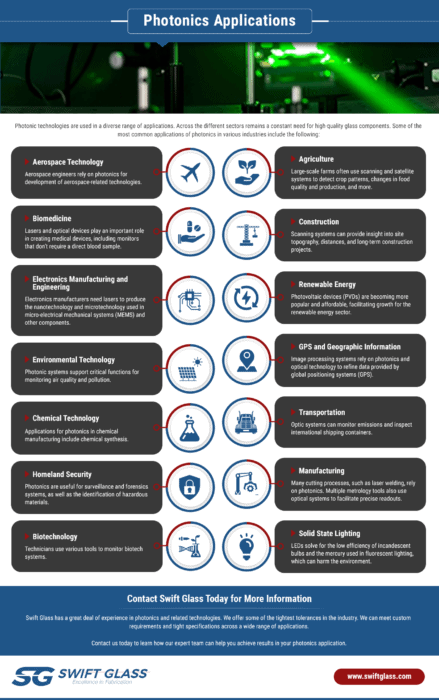Various light generation and harnessing processes are often used to cut and finish goods, transfer data, and monitor complex systems. These technologies fall under the umbrella of photonics. Electro-optical devices, optics and fiber-optics, and lasers each play an essential role in creating highly sophisticated products and scanning processes. Almost every industry uses various photonic processes to improve production quality, carry out complex tasks, and analyze systems.
The types of glass used in photonics are not dissimilar from the glass used in any other application. However, the delicate applications of photonics glass often demand tighter tolerance requirements.
Photonics Applications

Photonic technologies are used in a diverse range of applications. Across the different sectors remains a constant need for high-quality glass components. Some of the most common applications of photonics in various industries include the following:
Aerospace Technology
Aerospace engineers rely on photonics to create:
- Navigation: Optical pattern recognition systems, laser-based radar (LIDAR)
- Operations: HUD displays
- Testing: Imaging systems
Agriculture
Large-scale farms often use scanning and satellite systems to detect crop patterns, changes in food quality and production, and more. Photonic sensing systems can also help facilitate more precise control for irrigation and planting cycles.
Biomedicine
Photonics have enabled a variety of advanced medical procedures, such as laser-assisted surgeries and photodynamic therapy. Lasers and optical devices can also play an important role in creating medical devices, including innovative non-invasive glucose monitors that don’t require a direct blood sample.
Construction
Scanning systems can provide insight into site topography, distances, and long-term construction projects. Workers can also use laser technology to read barcodes and track materials.
Electronics Manufacturing and Engineering
Electronics manufacturers need lasers to produce the nanotechnology and microtechnology used in micro-electrical mechanical systems (MEMS) and other components, such as:
- Circuits
- Computers
- Engines
- Motors
- Semiconductor chips
Renewable Energy
Photovoltaic devices (PVDs) are becoming more popular and affordable, facilitating growth for the renewable energy sector. They are a crucial component in solar panels.
Environmental Technology
Photonic systems support critical functions for monitoring air quality and pollution. Two examples include the use of Fourier transform analyses to monitor particulates and UV Doppler optical absorption spectroscopy (UV-DOAS).
GPS and Geographic Information
Image processing systems rely on photonics and optical technology to refine data provided by global positioning systems (GPS). This makes images of the atmosphere and space more useful for coordination and tracking applications.
Chemical Technology
Applications for photonics in chemical manufacturing include:
- Chemical vapor deposition
- Fluorescence through controlled laser pulses
- Molecular optical spectroscopy
- Plasma etching
Transportation
Optic systems can monitor emissions and inspect international shipping containers. Ring laser gyroscopes also incorporate photonics to assist with navigation.
Homeland Security
Many security-related identification systems rely on photonics, such as DNA, retinal, and fingerprint scans. Photonics are also useful for surveillance and forensics systems, as well as the identification of hazardous materials.
Manufacturing
Many cutting processes, such as laser welding, rely on photonics. Multiple metrology tools also use optical systems to facilitate precise readouts.
Biotechnology
Technicians use various tools to monitor biotech systems. They also use optical spectrometers to verify compositions.
Solid State Lighting
LEDs are quickly supplanting both incandescent light bulbs and fluorescent lighting in a broad range of applications. LEDs solve for the low efficiency of incandescent bulbs and the mercury used in fluorescent lighting, which can harm the environment. Consumers, businesses, and governments use LEDs for exterior lighting, commercial lighting, and fixtures like traffic lights.
Advances in Photonics
Photonics is continually adapting and progressing to best fit the needs of various industries. Photonic networks, for example, can provide wireless photonic data transfers to distribute information from central locations to remote offices. Both digital baseband and Radio-over-Fiber (RoF) communication systems are popular due to their speed, reliability, and increasing drops in price.
Other advances in photonics include:
- Metrology, or precise measurement technology
- Navigation
- Opto-atomics, which integrate photonics in atomic devices for uses such as extremely precise time-keeping
- Opto-mechanics
- Polaritonics
While opto-mechanics, metrology, navigation, and polaritonics are adjacent to photonics, these branches of study use polarization to carry information and perform tasks. Microwave photonics is another adjacent field which combines optics and radio-frequency engineering to create new technologies. These technologies control, detect, distribute, generate, and measure microwave signals.
Contact Swift Glass Today for More Information
Photonic systems are crucial in almost every industry. They help people perform tasks, such as measurement, surgical operations, and manufacturing processes. Photonics also produces advanced scanning and analytics systems that can help monitor emissions, optimize transportation systems, and distribute data.
Swift Glass has a great deal of experience in photonics and related technologies. We offer some of the tightest tolerances in the industry. We can meet custom requirements and tight specifications across a wide range of applications.
Contact us today to learn how our expert team can help you achieve results in your photonics application.




